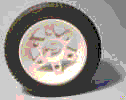|
 previous / next column previous / next column
A PHYSICIST WRITES . . .
(June 2004)
John Dunlop invented the pneumatic tyre to give his son a more comfortable time on his bicycle, and we should all be grateful to him for the similar benefit that we enjoy on car journeys as a result. Suspension systems and shock absorbers play their part, of course, but without the flexibility of tyres we would still be experiencing some of the discomfort of the era of the horse and cart, on rough roads at least.
There is a price to pay for this advance, however. I don’t mean the cost of replacing the tyres every so often, but the much larger amount that they add to your fuel bill.
Rubber gets its flexibility from being made of long folded molecules. The trouble is that they rub against each other and generate heat. If, for example, you stretch an elastic band quickly a few times it will become noticeably warm. In physicists’ language, of the energy that is put into bending or stretching rubber, not all becomes available (in the relaxing) for reuse — some is inevitably changed into heat because of the internal friction.
Now a tyre is always slightly flattened against the road (if it was pumped up hard enough not to be, it would be as uncomfortable as a cartwheel). So during each revolution of the wheel, every part of the tyre wall near the tread is bent and then straightened again. Truly, the tyres are the most long-suffering components of your car! Inside the rubber of the wall the molecules slide around and warm up. And who do you think pays for this wasted heat?
We can look at it another way: imagine you are having to push a vehicle along a smooth level road, out of gear, brakes off — why is a fair amount of effort required to keep it moving? A large part of the answer is the friction between those molecules in the rubber.
The technical name for what you are pushing against is rolling resistance. According to a recent test report on tyres from a consumers’ organization, with some brands your fuel consumption will be up to 6% higher than with others, because of their higher resistance to rolling.
I have since worked out something that the report didn’t mention: this 6% difference in mpg adds up to something like the cost of four tyres, over their lifetime mileage. In other words, by switching from the brand that wastes the most amount of your money in heat to the one that wastes the least, you could save enough to pay for the tyres themselves!
We are so accustomed to the comfortable journey that tyres give us, not to mention the life-saving grip they exert on the road surface, that it is easy not to think about them at all. It occurred to me only recently that the most remarkable feature of a tyre is a part that is normally out of sight.
Have you watched a tyre being eased onto its wheel hub? Even though the ‘bead’ can’t be stretched, it seems to slip over the flange of the hub as easily as anything. This is partly because the opposite side of the bead can slip down into the well of the hub. But also, when the tyre is in position between the two flanges (and out of the well) the ring of overlap between the rubber and the metal is only about two centimetres wide, or less than an inch.
When the tyre is pumped up, these narrow surfaces are of course pushed together by the air pressure inside. But what law of physics makes this attachment strong enough for it to support the weight of a vehicle, let alone transmit fierce acceleration and braking forces when required, or (most amazing of all) allow a car to be steered so violently that the tyres even squeal in protest — but still without the rubber and the metal pulling apart?
This is a mystery to me. It is also a tribute to the designers of tyres and wheel hubs. The thought of it ensures that I try never to give my tyres cause to complain audibly.
Peter Soul
previous / next column
|